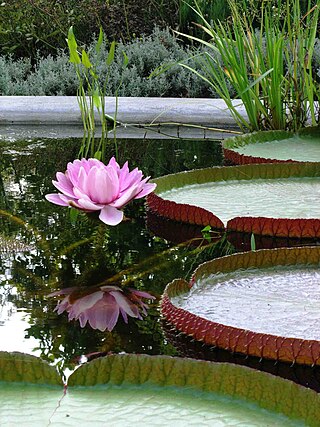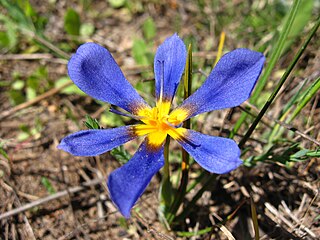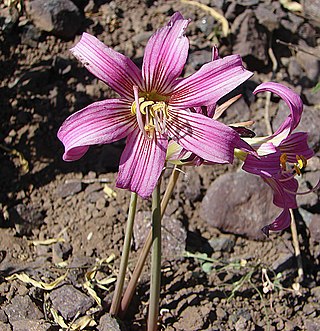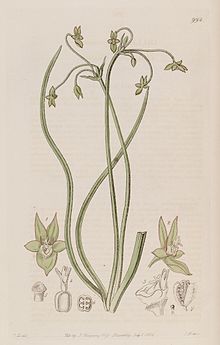
The flowering plant genus Ipheion belongs to Allioideae, a subfamily of the family Amaryllidaceae. The World Checklist of Selected Plant Families no longer recognize the genus, regarding it as a synonym of Tristagma, although The Plant List accepts two species.

Nothoscordum is a genus of New World plants in the onion tribe within the Amaryllis family. It is probably paraphyletic. The genus is native to North, Central and South America, though a few species have become naturalized in various parts of the Old World.

Victoria or giant waterlily is a genus of water-lilies, in the plant family Nymphaeaceae, with very large green leaves that lie flat on the water's surface. Victoria boliviana has a leaf that is up to 3 metres (9.8 ft) in width, on a stalk up to 8 metres (26 ft) in length. The genus name was given in honour of Queen Victoria of the United Kingdom. It pushes other water plants aside as it spreads out until only those of its kind remains. When this happens it has nearly completely cut out the sunlight from getting to any plants below the water limited only by circle packing.

Libertia is a genus of monocotyledonous plants in the family Iridaceae, first described as a genus in 1824. It is native to South America, Australia, New Guinea, and New Zealand. Eight species are endemic to New Zealand.

Olsynium is a genus of summer-dormant rhizomatous perennial flowering plants in the iris family Iridaceae, native to sunny hillsides in South America and western North America.

Leucocoryne(glory-of-the-sun) is a genus of bulbous perennials in the family Amaryllidaceae. The foliage of all species is long and narrow and has an onion-like scent. The blue, white or lilac flowers are held in umbels.

John Miers, FRS FLS, knight grand cross of the Order of the Rose, was a British botanist and engineer, best known for his work on the flora of Chile and Argentina.

Calydorea is a small genus of perennial, herbaceous and bulbous plants in the family Iridaceae native to Mexico and South America. The plants in the genus are small with tunicated bulbs. The flowers are light blue, violet, white, or yellow, depending on the species, of which there are around twenty. Taxonomists considered that the already known genera Salpingostylis, Cardiostigma, Catila and Itysa are not enough different from each other to justify their taxonomic segregation and, for this reason, all of them are now included in Calydorea.

Rhodophiala was a genus of herbaceous, perennial and bulbous plants in the Amaryllis family. It consisted of about 30 South American species distributed in southern Brazil, Argentina, and, specially, in Chile. Most of the species are known colloquially as añañuca. It has now been submerged in Zephyranthes.

Rhodolirium is a small South American genus in the tribe Hippeastreae of the family Amaryllidaceae. Although originally described by Philippi in 1858 it has long remained buried in other taxa, principally Hippeastrum and more recently Rhodophiala. Only in recent years has it been rehabilitated.

The Amaryllidaceae are a family of herbaceous, mainly perennial and bulbous flowering plants in the monocot order Asparagales. The family takes its name from the genus Amaryllis and is commonly known as the amaryllis family. The leaves are usually linear, and the flowers are usually bisexual and symmetrical, arranged in umbels on the stem. The petals and sepals are undifferentiated as tepals, which may be fused at the base into a floral tube. Some also display a corona. Allyl sulfide compounds produce the characteristic odour of the onion subfamily (Allioideae).

Amaryllidoideae is a subfamily of monocot flowering plants in the family Amaryllidaceae, order Asparagales. The most recent APG classification, APG III, takes a broad view of the Amaryllidaceae, which then has three subfamilies, one of which is Amaryllidoideae, and the others are Allioideae and Agapanthoideae. The subfamily consists of about seventy genera, with over eight hundred species, and a worldwide distribution.
Pierfelice Ravenna (1938–2022) is a Chilean botanist of Italian Jewish origin. His research interests are mainly in the field of South American Amaryllidaceae.

Phycella is a genus of herbaceous, perennial bulbous flowering plants belonging to the family Amaryllidaceae, subfamily Amaryllidoideae. The genus consists of five species distributed from central Chile to northwestern Argentina.

Solaria is a genus of South American plants in the family Amaryllidaceae, subfamily Allioideae, tribe Gilliesieae, native to Chile and Argentina. Kew treats Solaria as a synonym of Gilliesia.

Miersia is a plant genus in the Amaryllidaceae. The genus has 10 known species, 9 of which are endemic to Chile and one, M. rusbyi, endemic to Bolivia.

Gilliesieae is a tribe of herbaceous geophyte plants belonging to the subfamily Allioideae of the Amaryllis family (Amaryllidaceae). Described in 1826, it contains fifteen genera and about eighty species. It has been variously treated as a subfamily or tribe. It is native to the Southern United States, Central and South America, predominantly Chile. Of the three tribes of genera that make up the subfamily Allioideae, Gilliesieae is the largest and most variable. The tribe was divided into two tribes in 2014, Gilliesiae s.s. and Leucocoryneae, based on differences in floral symmetry and septal nectaries.
Erinna is a genus of perennial herbaceous geophytes in the flowering plant family Amaryllidaceae. It is native to Chile, South America. It is included in the tribe Gilliesieae, within the subfamily Allioideae. The genus is monotypic, with a single species, Erinna gilliesioides. It is relatively rare.

Allioideae is a subfamily of monocot flowering plants in the family Amaryllidaceae, order Asparagales. It was formerly treated as a separate family, Alliaceae. The subfamily name is derived from the generic name of the type genus, Allium. It is composed of about 18 genera.















